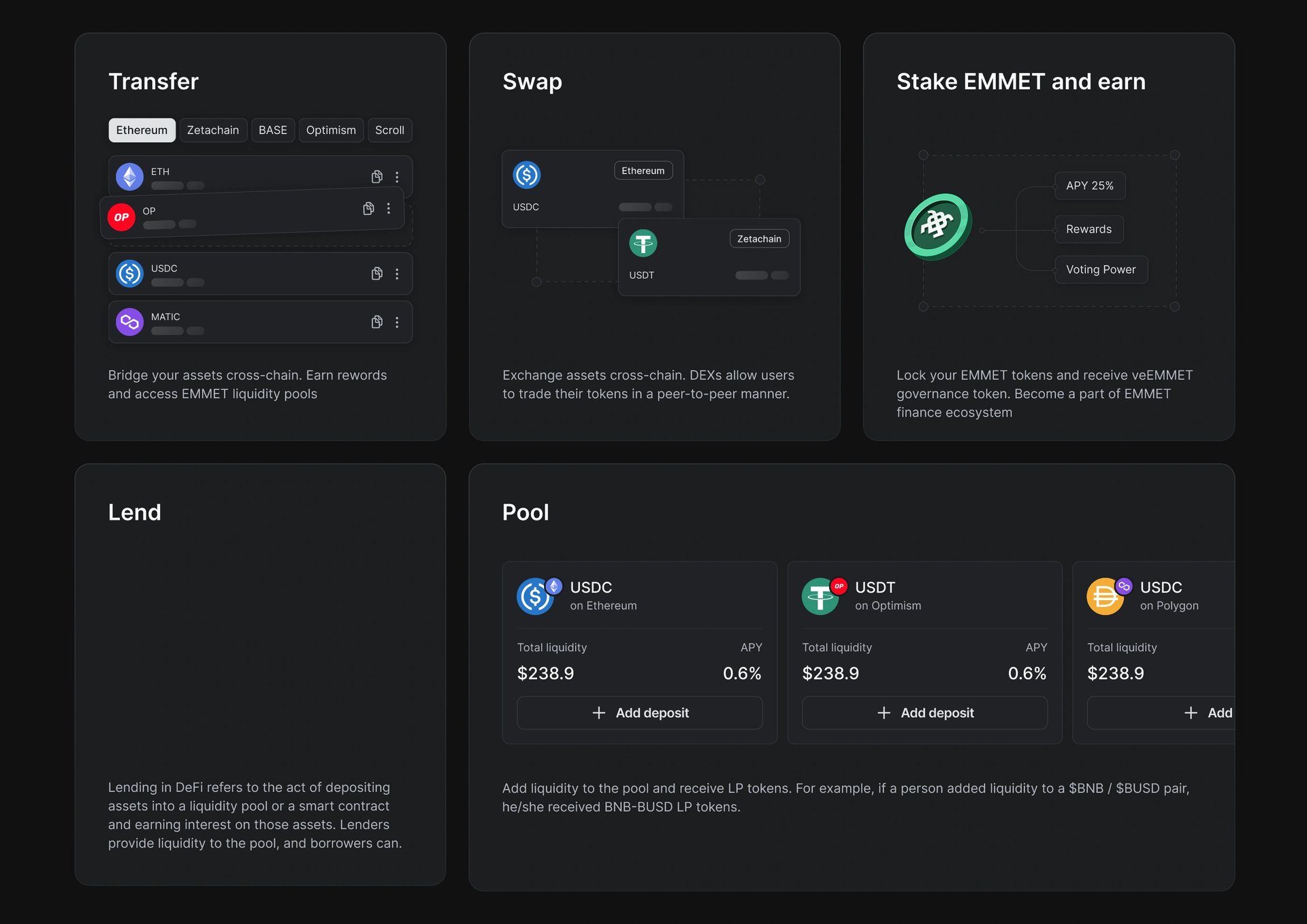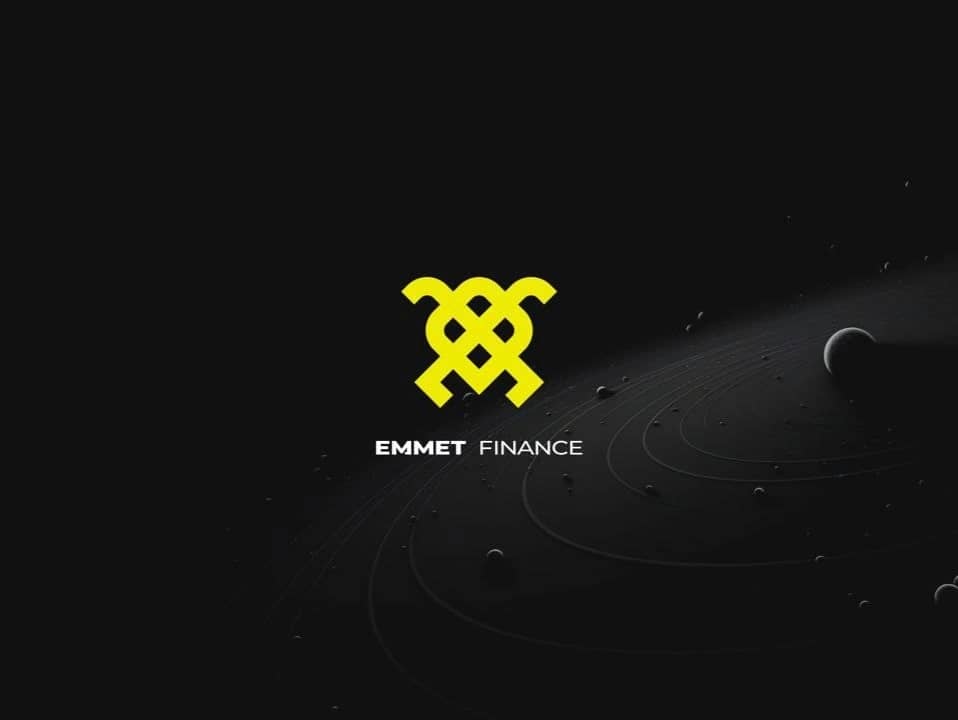订阅 wiki
Share wiki
Bookmark
Emmet Finance
Emmet Finance
Emmet Finance 是一个跨链去中心化金融平台,促进跨多个区块链网络的资产转移、借贷和交换。它具有由其EVM兼容的区块链支持的统一基础设施,从而实现EVM和非EVM链之间的互操作性。[1]
概述
Emmet Finance 是一个跨链 DeFi 平台,为跨多个区块链网络的交换、借贷和挖矿提供统一的基础设施。它具有一个去中心化的消息传递系统 (ECCM),该系统支持 EVM 和非 EVM 链之间的安全通信,从而允许不同网络上的智能合约无缝交互。该平台支持多种桥接选项,包括通过锁定和销毁机制进行的代币转移、Circle 的跨链转移协议以及在链之间维护资产池的流动性桥。
Emmet 还集成了一个多链交换聚合器,该聚合器从各种去中心化交易所获取最佳交易路线。其借贷系统使用共享流动性池来提高资本效率并减少碎片化。这些操作由 Emmet 链间网络 (EIN) 提供支持,EIN 是一个 EVM 兼容的区块链,用于协调跨链活动。其他功能包括治理参与、跨链收益耕作以及跨支持网络(如 Ethereum、Solana、Arbitrum 和 Polygon)的投资组合跟踪。[2]
产品

ECCM
Emmet 跨链消息传递 (ECCM) 是一种去中心化的通信系统,支持 EVM 和非 EVM区块链网络之间的安全交互。它支持跨不同区块链架构的消息和数据传输,从而满足去中心化金融中的互操作性需求。
该系统具有基于 智能合约 的 共识机制,该机制使用 拜占庭容错 (BFT) 多重签名来验证链上跨链交易。这种方法可确保透明度,并消除对中心化基础设施的依赖。来自接收链的反馈循环确认交易的成功或失败,从而允许在必要时进行反转以维护数据完整性。
ECCM 强调去中心化和可审计性,从而为跨链操作提供安全可靠的框架。它连接各种区块链环境的能力支持开发更集成和灵活的 DeFi 应用程序。[3]
链间网络
Emmet 链间网络 (EIN) 是一个 EVM 兼容的区块链,旨在支持 Emmet Finance 的跨链操作。它充当连接多个 EVM 和非 EVM区块链的协调和安全层,从而实现跨平台 DeFi 服务的互操作性。
EIN 持续监控集成链以检测可疑活动,并支持远程过程调用 (RPC) 以直接跨网络执行操作。这允许系统在安全事件期间进行干预,例如暂停受损合约或将资产转移到更安全的位置。作为 Emmet 混合桥的安全基础,EIN 托管 验证器共识机制,该机制通过 验证器的去中心化网络验证跨链交易。
该网络还通过使 智能合约 能够自动响应潜在威胁来增强 Web3 安全性,从而帮助防止漏洞的蔓延。EIN 作为 Emmet 跨链 DeFi 中枢的支柱,为跨多个区块链的安全高效交换、借贷和其他去中心化金融操作提供所需的基础设施。[4]
治理
Emmet Finance 使用去中心化治理系统,该系统使 EMMET 代币持有者能够参与与平台开发和运营相关的决策。去中心化、透明度、包容性、安全性和长期可持续性原则指导治理。社区集体做出所有决策,投票和提案活动记录在链上以实现问责制。
治理流程从提案提交开始,任何 EMMET 持有者都可以提出与协议升级、费用结构、功能或国库使用相关的更改建议。提案必须满足最低要求,并进入讨论阶段以征求社区反馈和改进。经过审议后,符合资格标准的提案将进入投票阶段,其中代币加权投票决定其结果。批准的提案随后由开发团队或指定团体实施,然后进行实施后审查以评估影响并为未来的行动提供信息。存在紧急治理流程来处理紧急问题,从而允许在更严格的法定人数或批准阈值下加速决策。[5]
EMMET
EMMET 代币是 Emmet Finance 的原生资产,旨在支持平台内的治理、实用性和用户激励。代币持有者可以对协议更改(例如费用调整和功能提案)进行投票,从而实现去中心化决策。EMMET 通过支持消息传递和资产转移来减少整个生态系统中的 交易费用 并支持跨链操作。
该代币还可以被质押以赚取奖励并参与 流动性池,从而为平台的整体功能做出贡献。用户通过提供流动性、使用桥接服务和贡献反馈等活动来赚取 EMMET,从而加强参与和生态系统参与。[6] [7]
代币经济学
EMMET 的总供应量为 10 亿个代币,并具有以下分配:[8]
- 战略储备:24%
- 团队:12%
- 公司运营:10%
- Pre-seed(开放):8%
- 国库:7.5%
- 生态系统基金:7%
- DEX 和 CEX 上市:7%
- 跨链扩展:7%
- Private Seed:5%
- 战略投资者:5%
- 空投:3%
- 顾问:2%
- 启动板销售:1.5%
- KOL:1%
合作伙伴
发现错误了吗?
